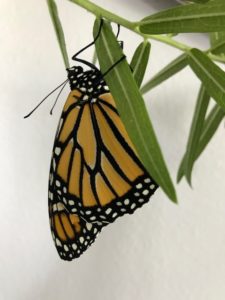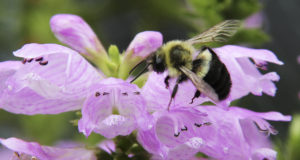Welcome Back!
Spring is the time for ‘first of the year’ observations. It’s always fun to see old friends returning to the active prairie landscape each year. After hanging around on some of the same prairies for more than 25 years, I am getting pretty good at knowing when the first grasshopper sparrow, upland sandpiper, or dickcissel will show up. I also know where they’ve come from because they’ve been well studied and people report sightings up and down their migratory path.

Monarch taken by Kate Sulentic
I enjoy the fact that other migratory species like monarch butterflies, dragonflies, and others are starting to get the same kind of attention. You can go to the Journey North website, for example, and look at real time maps of how migrations of monarchs are progressing, along with a growing list of other species. If you like, you can even contribute your own sightings (Kim spotted our first monarch here on Saturday, so I reported it to the site).
The more research we do on the life histories of species (and the more I read about research that’s already been done) the more species we add to the long list of migrants. Many other butterflies besides monarchs are on that list. Orange sulphurs, painted ladies, red admirals, buckeyes, and mourning cloaks are just a few. I’ve also started assuming that most dragonflies I see are probably migratory, whether scientists have figured it or not. That might be overreaching, but let’s wait and see…
Many moths are migratory too, something I learned more about and reported back in 2012. Of course, the migratory moths that we know the most about are the species that cause us economic damage – like the army cutworm. Think of all the other species that could be migratory, but who’s paying attention?
It feels like I’m constantly finding out that another species is migratory. Often, my revelations don’t come because of new science, but rather my own reading of what scientists have long known. The latest example came this weekend when I was reading up on large milkweed bugs (Oncopeltus fasciatus). As it happens, in more northern climates – including Nebraska – they can’t survive over the winter and at least some adults migrate south. Then they migrate back north the next spring/summer. I’m guessing the northward-moving group is a different generation than those moving south but I wasn’t able to confirm that during my information search.
Of course, there are many species that do overwinter, even in regions far colder than Nebraska. Small mammals, of course don’t fly south (AS FAR AS WE KNOW!) and most other small vertebrates, especially small ones, stick around all winter too. Birds are the major exception, but even some birds hang out all year in the same place. Others, like meadowlarks, seem to just shift everyone southward. We can still see meadowlarks in the middle of the winter here – they’re probably just birds that summer in places like North Dakota and Saskatchewan, so Nebraska winters probably feel balmy to them.
Despite the fact that a surprising number of invertebrates migrate, there are many more (I think?) that stick around for the winter. Watching for their first appearance each spring is a great way to figure out whether they overwinter as adults, eggs, or larvae. For example, seeing grasshoppers or leafhoppers at their full adult size and with functional wings in April or early May is a good indication that they overwintered as adults. However, there’s a lot of variation within insect groups, so seeing an adult grasshopper in April doesn’t mean all grasshopper species follow that same pattern. In fact, most of the grasshopper species I find in the spring are tiny little nymphs, which I assume hatched out of eggs within the last week or so. There were scads of those tiny nymphs around our family prairie over this last weekend.

Bumblebee taken by Carl Kurtz
Of all my ‘first sightings’ each spring, one of my favorites is the bumble bee, or to be exact, any of a number of bumble bee species. Unlike honey bee colonies, bumblebee colonies die out each fall, with the exception of a few fertilized females who will found new colonies the following spring. Those massive females find a secure place to spend the winter and then can be seen early the next spring searching for a nice burrow or other cavity to host their new colony. They then lay eggs and collect enough pollen and nectar to raise that first generation to adulthood before becoming a full time resident of the nest, laying more eggs and being taken care of by her children. Seeing a ponderously-large bumblebee each spring always makes me very happy.
Many solitary bees make their appearance early in the spring too, including the small carpenter bees I wrote about last week. (Good news! I was wrong – they’re still around. Now I have to see if there are any females among them.) However, others wait to emerge until their favorite food plants are blooming, which might not be until late in the field season. Watching for new bee species to appear on the scene as the season progresses each year is a relatively new activity for me, but one I’m really enjoying.
Of course, I haven’t even talked about plants yet. Tracking the annual progression of emergence and flowering of plants is also very satisfying. Watching the schedules change as the climate changes brings a variety of emotions, but despite the gradual shift, the same orderly progression happens each year.
Every first appearance of a species in the spring is a little bit of comfort and joy for me. Especially when the world around me feels stressful and/or out of control, seeing an old friend appear right on schedule makes it seem like maybe everything is OK after all.
Originally published in The Prairie Ecologist.
Tags: bird migration, Chris Helzer, migration

